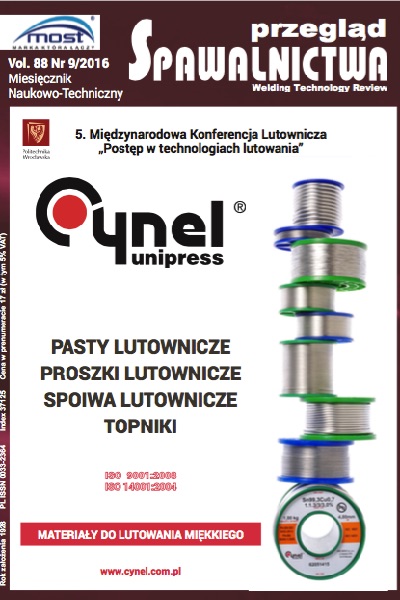Wpływ składu mieszanin NiCrBSiFe+WSC i NiBSi+WSC na ich mikrostrukturę i twardość
Main Article Content
Abstract
Powłoki nanoszone metodą lutowania infiltracyjnego charakteryzują się wysoką odpornością na zużycie ścierne oraz dużą twardością. Z racji na wysoką komplikację nanoszenia powłok, postanowiono wykonać wstępne próby na drodze spiekania ziaren węglikowych z fazą ciekłą. Przeprowadzone badania miały na celu wstępne rozpoznanie różnic pomiędzy proszkami NiCrBSiFe a NiBSi w kontekście mikrostruktur i twardości otrzymanych kompozytów. Posłużyły one do zaplanowania koncepcji dalszej pracy badawczej. Projekt prowadzony był we współpracy z firmą AGRO// SELNET.
Influence composition of mixtures NiCrBSiFe+WSC and NiBSi+WSC on their microstructure and hardness
Abstract
Infiltration brazed coatings are characterized by high wear resistance and high hardness. Because of the high complexity of coating process, it was decided to perform the initial samples by sintering the carbide grains with a liquid phase. The study aimed to initial recognition of the differences between NiCrBSiFe and NiBSi alloys in the context of the microstructure and hardness of the composites. These were used to plan the concept of further research. The project was performed in cooperation with AGRO//SELNET Company.
Downloads
Article Details
Creative Commons CC BY 4.0 https://creativecommons.org/licenses/by/4.0/
Welding Technology Review (WTR) articles are published open access under a CC BY licence (Creative Commons Attribution 4.0 International licence). The CC BY licence is the most open licence available and considered the industry 'gold standard' for open access; it is also preferred by many funders. This licence allows readers to copy and redistribute the material in any medium or format, and to alter, transform, or build upon the material, including for commercial use, providing the original author is credited.
References
Coating metallic substrate with powdered filler and molten metal, US Patent nr 3743556, 1973.
Tobar M.J., Alvarez C., Amado J.M., Rodriguez G., Yanez A.: Morphology and characterization of laser clad composite NiCrBSiWC coatings on stainless steel, Surface & Coating Technology, 200 (2006) 6313-6317.
Fernandes C.M., Senos A.M.R.: Cemented carbide chase diagrams: A review, Elsevier B.V., 2011.
Schwartz M.: Brazing, 2nd Edition, ASM International, 2003.
Senkara J.: Sterowanie energią adhezji pomiędzy molibdenem i wolframem a ciekłymi metalami w procesach spajania, Wydawnictwa Politechniki Warszaskiej
Senkara J., Windyga A.: Podstawy teorii procesów spajania, Wydawnictwa Politechniki Warszawskiej, Warszawa 1990.
Morel S.: Powłoki dla ochrony przed zużyciem elementów maszyn i urządzeń, w: Przegląd Spawalnictwa, Vol. 87, No 9 (2015).
Kondej A., Babul T.: Mikrostruktura natapianej powłoki Ni-Cr-B-Si, Przegląd Spawalnictwa Vol 88, No 3 (2016).
Broda T., Keitel S.: Resistance seam hardfacing and cladding of WC-Co in a NiCrBSi-Matrix, w: Przegląd Spawalnictwa, Vol 88, No 3 (2016)
